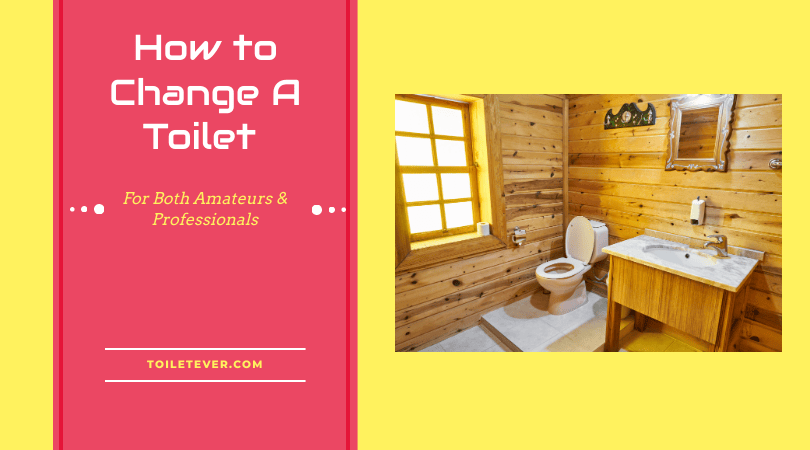
A toilet is a very important part of any house. It’s where we all go to relieve ourselves, and it’s also the place where our waste goes as well. As such, you must take care of your toilet by changing the parts when they need to be changed. This article will show you how to change a toilet for both amateurs and professionals to make sure that everything is done correctly!
Toolkits to Change A Toilet
To change a toilet, you will need the following:
- Toilet handle
- New seal (included with new tank)
- A wrench or pliers to remove fittings and bolts
- New toilet
- Plunger
- Screws
- Screwdriver
You’ll also want to have some basic tools on hand for any adjustments that might be needed. These can include screwdrivers, metal tape measures, rubber mallet/hammer, bucket, and sponges. You should also have safety goggles as well! Once you’ve made sure all your equipment is available – now it’s time to get started by removing the old one first!
Let me explain how they do it.
DIY Guide: How To Change A Toilet (Amateur Method)
If you want to change your home toilet by yourself, you can do it easily by following some steps. Here you will see these steps:
- The first step is to unplug the toilet.
- The second step is taking off the tank lid.
- Third, you will see a gasket metal or rubber ring that should be replaced with a new one included in your package of a new tank and sealant put on it.
- Fourth, you have to remove fittings and bolts of the old seat from your toilet bowl by using pliers or wrench as well as removing caps on the bottom sides of tanks which are not used during the installation process (unless they leak).
- Fifth, after loosening these nuts around the drain hose connector threaded pipe located underwater fill valve up towards rear wall behind closet flapper valve; then you can use this time to clean out any sediment buildup inside pipes. Because there might be some difficulty when you are removing plugs from the tank.
- Sixth, after adjusting all fittings and nuts on the new seat, you can set it in place with washers and bolts that came with the installation kit but not too tight because there will be some plumber sealant to fill gaps between seats & toilet bowl & under tanks.
- Seventh put back the old gasket again by using a pry bar or screwdriver to reinstall the tank lid; then tighten up screws with an Allen wrench or Phillips head screwdriver.
- And finally, we need to connect hoses together first before water is turned on to that make sure they are fitting securely.
- Then turn your water supply valve off if necessary as well as remove any excess pipe sections left around during the installation process.
- And when you turn the water supply valve back on, do it gradually to make sure there are no leaks in your system and that all of the connections are secure before turning off the water supply again. And then finally test sitting down onto toilet seat
- As the last step after tightening bolts underneath the tank lid with an Allen wrench or Phillips head screwdriver, tighten up screws under the tank lid using the plumber’s sealant-covered bolt as well.
Hope you found the full process very easy. But if you can’t make it done, then you are okay to call a professional to do it on your behalf.
Let us explain how to change a toilet by an expert.
DIY Guide: How To Change A Toilet (Professional Method)
Well, now we are going to tell you the expert procedures to change a toilet easily within a short time.
Step One: Remove The Toilet Base
It means you need to unscrew the bolts which are under of toilet base. And then lift it off and lay on its side, freeing whatever is underneath so that everything can be cleaned. There may also be some pipes or other connections if there’s a water supply line for flushing purposes (which often goes into the wall). If not, just leave those alone since they’re not relevant when doing this job. Now your old toilet has been exposed! It will probably have two nuts holding the tank onto the bowl–one at each end of it–and they’ll usually require an Allen wrench or Phillips head screwdriver to loosen them up before removing. With one nut removed from each end, the tank will now be able to slide off and you can set it aside.
Step Two: Clean The Toilet Bowl And Tank Base Areas
All dirt and grime from underneath where the water sits mustn’t be left behind when installing new parts (or else you’ll experience some major leakage).
Find a toilet cleaner and spray all areas of the bowl with it to break down any leftover gunk or dirt. Then grab an old rag, paper towel, or sponge (or whatever you have on hand) and go over the area again. Make sure that there’s nothing left behind! Tip: Don’t forget about those pesky bolts–spray them too!
Step Three: Purchase New Toilet Parts And Install Them
Now is time for upgrading your new toilet by picking out parts that suit your needs best from home improvement stores like Home Depot, Lowes, Ace Hardware (etc.). There are many different options available depending on how much water use you need at one sitting as well as what kind of material you want to use. Just remember the water usage and materials when picking out your new toilet parts!
Types of Toilet Parts:
- Regular Size Flapper (flushes every time)
- Large Size Flapper (holds more waste & doesn’t leak as much)
- Wax Ring Protector, Grey Foam Rings with Cracks in Them, or Caulk Sealant–to seal where the base meets the floor. This is a MUST for any cracked ceramic bowls that have had continual leaks over time!
Step Four: Buy the Hinges
Small Size Flapper or Tank Ball–to help people on the toilet last longer while also providing a little more water for those with sensitive bladders, such as women. With this option, you will need to purchase an adapter kit too which is specific to your tank size and how many holes are available in it!
Step Five: Install New Toilet
You’ll want to make sure that there’s plenty of room under the bowl before installing it by using at least three inches from either side (or below) so that when someone uses the bathroom they won’t hit their knees against anything. You may have some problems if you’re missing vents around where your new toilet would be installed because then all of the waste smells will be concentrated in the area.
Step Six: Connect Waste Line & Close Up Flooring
You’ll want to connect your waistline that’s been installed throughout this process and close up any flooring so that everything is sealed again before you’re done with it! You can’t install a toilet without making sure there are no leaks or smells coming from anywhere possible, otherwise, you have what many homeowners call “the smell of death” inside their home after they’ve just remodeled.
Tips: Read instructions carefully; take your time installing plumbing–don’t rush it! Purchase a new toilet seat for installation if needed (most likely not)! Remember to use plumbers tape around all joints before tightening down nuts on pipes/toilet seat connections.
A good rule of thumb is to read instructions carefully, take your time installing pipes–don’t rush it! Purchase a new toilet seat before installation if needed (most likely not)! Remember to use plumbers tape around all joints and tighten down nuts on connections.
Conclusion
If you have any questions about how to change a toilet or find that information in this article was helpful please leave feedback to me below & I’ll get back to you as soon as possible. Thank You for reading my blog post today!
Enjoy!



